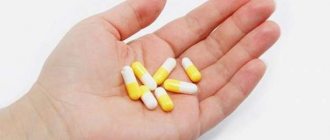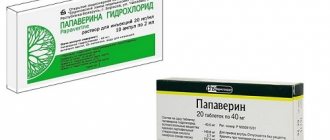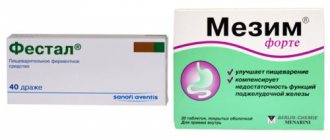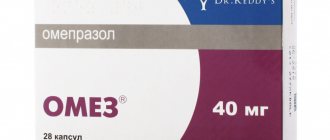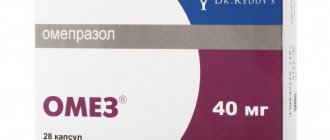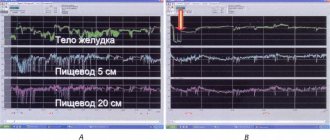Omez and Nolpaza are drugs from the same pharmacological group of anti-rhodium drugs, they have almost the same indications, and the reason for their use is pathological processes occurring in the stomach or intestines.
They can also be used in the treatment of esophageal diseases.
These drugs belong to proton pump inhibitors, they can significantly reduce the amount and synthesis of acid that causes stomach pain. The characteristic for the group of these drugs is that it is administered in the morning, most often orally, on an empty stomach.
These medications have the same effect on the systems and organs of the human body. They influence the enzymatic phase (“acid pump”), inhibiting its excessive work and normalizing the physiological function of the stomach.
Nolpaza composition and release form
Let's think about the forms of release of the drug:
- Nolpaza is produced in the form of tablets that contain the substance pantoprazole. Its content depends on the tablet form and is 20 or 40 mg.
- Another form of release is powder (lyophilization), it is used for intravenous administration. The volume of the main chemical element does not exceed 40 mg.
- To eliminate negative symptoms (acid reflection, pain, heartburn).
- For preventive purposes, it is allowed to use gastric or intestinal chatter.
- It works therapeutically, eliminating the consequences of the negative effects of drugs belonging to the NLPZ group (Diclofenac).
- It can be used as a supporting agent in combination with antibacterial drugs. For Helicobacter Pylori therapy.
- In development by Zollinger-Ellison.
- It is used in the prevention of seasonal exacerbations of chronic inflammation of the pancreas.
Instructions for use of Nolpaza
How to use the drug:
- If this medication is prescribed as a single application, it is best to take the tablet in the morning on an empty stomach, one hour before meals. It should be rinsed with the right amount of water without crushing or chewing.
- If NolPaza is prescribed twice daily, the second tablet should be taken one hour before lunch.
- For diseases of the esophagus, inflammation or contraction of the esophagus, gastric reflux, the dose of mucus water is 20 mg per day. If the disease progresses to a moderate or severe form, the dose of the drug is increased to 80 mg per day.
The duration of treatment is determined by the doctor, usually lasting one and a half months.
Dosage
Dosing Schedule:
- If necessary, an additional dose of the drug (20 mg) can be used.
- A daily dose of up to 80 mg is recommended for diseases of the stomach and intestines associated with the appearance of ulcers. This therapy continues for 8 weeks.
- Complex use with antibacterial drugs (in the treatment of Helicobacter Pylori) occurs at a dose of 40 mg per day. This medication is taken throughout the entire period of antibiotic use.
- For other diseases that result in increased acidity (Zollinger-Ellison disease, inflammation of the stomach), nolpaz is prescribed twice a day, and its dose should not exceed 80 mg per day.
- In rare cases, under the supervision of a physician, the daily dose can be increased to 160 mg; the duration of treatment is determined closely individually.
- Nolpaza can also be used parenterally (intravenously or as a drip infusion). This method of administration is used when the tablet form is not oral. If such restriction is stopped, injections are replaced by the use of tablets.
- Lyophilisate and tablet forms have the same effect. When used intravenously, NolPaza is slightly faster.
Legal aspects
Today it is clear that the interaction of H. pylori
with the human body is complex, to some extent individual and not fully understood.
The physician should know that H. pylori
reduces the risk of esophageal diseases (including malignant ones) [12–14], bronchial asthma and atopy, and possibly obesity and diabetes mellitus, and take this into account when prescribing treatment [15].
What should a practicing physician do in a situation of conflicting clinical recommendations? It is often claimed that eradication of H. pylori
is indicated for everyone who has it, based on various protocols, standards and clinical recommendations.
In order for the doctor not to find himself in a difficult legal situation, it is very important for him to know the basic provisions of Federal Law No. 323 “On the fundamentals of protecting the health of citizens in the Russian Federation.” On December 18, 2022, the President of the Russian Federation signed Law No. 489-FZ “On Amendments to Article 40 of the Federal Law “On Compulsory Health Insurance in the Russian Federation” and the Federal Law “On the Fundamentals of Protecting the Health of Citizens in the Russian Federation” on Clinical Recommendations.” The use of clinical recommendations in our country has become regulated not just by an order of the Ministry of Health of Russia, but by the amended Federal Law No. 323, Article 37 of which stipulates that clinical recommendations must be approved in the established manner before December 31, 2022. Previously approved clinical recommendations (treatment protocols) are applied until their revision in accordance with Federal Law No. 489 of December 25, 2022 only until December 31, 2021. From January 1, 2022, only those clinical recommendations that are posted on the official website of the Russian Ministry of Health will be in effect. Moreover, for each disease, condition (group of diseases, conditions) for adults and children, no more than one clinical recommendation can be approved and approved, respectively. For peptic ulcer disease, clinical guidelines have existed since 2022. They recognize peptic ulcer disease after surgical treatment as the only basis for eradication of H. pylori
(recommendation level A, level of evidence certainty 1) [16].
Contraindications to the use of Nolpaza
Despite the fact that patients feel significant improvement while using nolpaz, the use of this medicine has the following contraindications:
- Omez is contraindicated in children of all ages.
It is not prescribed to patients who have stomach upset as a result of nervous diseases.
- Children of all ages.
- If the patient was hypersensitive to pantoprazole and its analogues.
- In the absence of sensitivity to fructose compounds.
- Hypitaminosis resulting from deficiency of vitamin B12 (cyanocobalamin).
- Malignant changes.
Nolpaza is prescribed with increasing caution:
- Pregnant.
- Breastfeeding period.
- Inadequate kidney and liver function.
Clinical guidelines
We have already discussed above what recommendation all doctors will use when eradicating H. pylori
.
The following clinical recommendation is not accepted by all, but by most physicians: eradication therapy is recommended for all patients with peptic ulcer disease who test positive for H. pylori
to prevent subsequent relapses of peptic ulcer disease (level of recommendation B, level of evidence 2) [16] .
Recommendation for eradication therapy to prevent peptic ulcer disease and its exacerbations for all persons with H. pylori
in the absence of contraindications, a minority of knowledgeable doctors will probably use it (level of conviction of recommendations C, level of certainty of evidence 5) [16], i.e., for some patients, implementation of this recommendation, as already written above, can do more harm than good, especially since taking into account new data [12].
But for a number of patients with a family history, this recommendation may be appropriate, although the recommendations for stomach cancer approved by the Russian Ministry of Health in the section “Prevention of stomach cancer” do not contain instructions on eradication therapy for all patients infected with H. pylori
.
A final limitation of the study [14] is the lack of data on the relationship between H. pylori
and gastric cancer incidence and mortality. However, reducing the effect of smoking and a high-salt diet on the incidence of gastric cancer, especially among men and East Asians, may be an optimal option for primary prevention [12–14].
Side effects of Nolpaza
Adverse reactions associated with taking nolpase can cause disorders in the functioning of various organs and systems.
If there is a violation of the drug dosage, or it was used alone, without a doctor’s prescription:
- Spastic, sharp pain is an adverse effect of nolpaz
The hematopoietic system can react with:
- Reduced number of white blood cells (leukopenia).
- Blood clotting disorders that accompany a decrease in the number of platelets (thrombocytopenia).
- There may be in the stomach and intestines: Spasmodic, sharp pain.
- The appearance of nausea and, consequently, the occurrence of vomiting.
- Dryness of the mucous membranes of the mouth.
- Enlarged plump.
- In laboratory studies, transaminase levels increase.
- In rare cases, jaundice occurs with severe liver damage.
- Itchy skin and rash.
- Painful thickening of muscles.
In addition to the above symptomology, intermediates may join:
- There is peripheral edema of the lower extremities.
- Hypertermia.
- Increased fatigue, general decrease in strength, weakness.
- Body weight may change.
- Blood chemistry values may change during laboratory testing. Increased cholesterol and bilirubin values, decreased magnesium and sodium values.
Overdose of Nolpaza
There were no side effects in overdose form during the entire period of use of Nolpaz. But their development is possible. This will be determined by the severity of symptoms of adverse reactions and symptoms of general poisoning.
In severe cases, hospitalization and then the use of detoxification solutions and plasma substitutes are possible.
Average price of NolPaza in the form of 20 mg 14 tab tablets. This is 170 rubles.
Nolpaza 40 MG 14 tablets will have a price of 260 rubles.
Omez release form and composition
Omez is a medicine belonging to the group of proton pump inhibitors. Used to treat various pathologies of the stomach, which is accompanied by increased synthesis of hydrochloric acid.
The heart of Omez is the chemical compound omeprazole, it also uses additional ingredients:
- Sodium hydroxide and hydrogen phosphate.
- Mannitol.
- Medical talc.
- Saccharise
Omez is available as:
- Omez in 20 or 40 mg capsules, foil-coated after 10 pieces. Conversions are released in cardboard boxes after 3 pieces.
- Omez Insta, has a white powder form, has a delicate mint scent and is available in 20 mg sachets. The package contains 5, 10, 20, 30 pieces, and is accompanied by a detailed instructions on the use of the drug.
- Omez powder. It is available in 40 mg vials for infusion use. It is a homogeneous, porous, white powder.
Indications for use of Omez
It is very important to perform a stomach and intestinal endoscopic examination before using the drug. It is imperative to exclude pathological presence on oClock. Since the use of OMEZ can blur and mask the clinical picture of an oncologist.
Omez is prescribed in the following cases:
- Underwear that appears to be influenced by psycho-emotional factors and stressful situations
Pathological stomach and intestines, which are accompanied by the development of ulcers and derrengenia.
- When it is necessary to carry out therapy due to the side effects of anti-inflammatory drugs with non-steroidal effects.
- An independent disease that appears under the influence of psycho-emotional factors and stressful situations.
- Zollinger-Ellison disease.
- Changes in the upper part of the stomach and esophagus.
- Infectious diseases that reduce the amount of positive mucosal lining of the mucosa and intestines.
- Treatment of the effects of negative symptoms in gastric mucosal inflammation (heartburn, acid reflux, increased gas production).
Available in capsule form in the same range as lyophilized powder for parenteral use. After intravenous administration, Omez lasts longer and faster.
What is better to take – Omez or Nolpaza
Omez is an older medicine. Its action is faster, more aggressive. If you need to relieve pain and eliminate heartburn one-time, then Omez will be more effective.
When preventing relapses, the need for long-term use, and a high probability of contraindications, Nolpaza will prove to be more reliable.
It is less likely to cause side effects and is gentler on the intestines and stomach.
The drug reduces the production of pancreatic enzymes by slowing the production of hydrochloric acid. In acute pancreatitis, it is possible to stop the inflammation process or prevent the exacerbation of a chronic disease.
Instructions and doses of Omez
It is usually given in a single dose (20 or 40 mg) in the morning on an empty stomach. The drug should be swallowed while sipping water; the capsules should not be chewed.
How to use:
- A daily dose of 20 mg is recommended for intestinal or stomach ulcers. The duration of treatment with Omez can be up to 60 days.
- For erosive diseases, the drug is prescribed twice a day in one capsule (20 mg). If the pathological process occurs in a severe form, the use of the drug is allowed for 60 days.
- To prevent seasonal worsening of the disease, the recommended dose is 20 mg.
- The Zollinger-Ellison team calls for a higher dose of Omez, which is prescribed individually, averaging 80 mg. And divided into two doses throughout the day.
- Omez is not recommended in all trimesters of pregnancy and is not indicated during breastfeeding. In some cases it is prescribed, but there is increased medical supervision if necessary in a hospital setting.
- In case of heartburn, Omez is most often taken as an unplanned dose of one capsule. For this, it is very good to use OMEZ Insta in the form of a suspension.
- Omez in gastric pathologies. If the patient has been diagnosed with reflux of the gastric mucosa, esophageal compression or esophagitis, the drug is prescribed at a dose of 20 mg per day, in the morning. If the patient has symptoms of inflammation of the stomach, then get rid of the pain syndrome, and normalize the acidity of the stomach, 20 to 40 milligrams of this agent are prescribed. The dose may be divided into a morning and evening dose. For stomach scars and intestinal ulcers, as well as to relieve pain, 40 mg of Omez is prescribed, which can be used for 60 days.
- Omez is prescribed only from the age of five. The amount of the drug used is prescribed at a dose of 5 mg per 10 kg of body weight. The resulting amount of the drug is used once at the beginning of the morning on an empty stomach.
- In the prevention of seasonal exacerbations of pancreatitis, inflammation of the stomach, ulcers, the drug is prescribed in a dose of 20 mg.
Omeprazole or pantoprazole: hot points of discussion
Proton pump inhibitors (PPIs) occupy a leading place among the drugs for the treatment of diseases associated with high gastric acid production. Currently, this pharmacological group includes omeprazole, lansoprazole, pantoprazole, esomeprazole and rabeprazole. Some aspects of the debate regarding the benefits of a particular PPI need to be illuminated and understood. Particularly heated debates surround omeprazole and pantoprazole, which are similar in their pharmacodynamic characteristics and clinical effectiveness. Let us consider the differences discussed in the light of available information on the clinical pharmacology of these drugs.
Mechanism of action of PPIs
The mechanism of action of PPIs is the blockade of H+/K+-ATPase, the enzyme responsible for the main step in the formation of hydrochloric acid (HCl). Irreversible (or long-term) blockade of the enzyme explains the long duration of the main pharmacodynamic effect of PPIs, significantly exceeding the time these drugs remain in the blood. PPIs are benzimidazole derivatives and are prodrugs, that is, ideally they form an active form only in the secretory tubules of parietal cells, into the lumen of which sections of H+/K+-ATPase molecules protrude.
PPIs are unstable in an acidic environment; the likelihood of their penetration from the gastric cavity into the secretory tubules of parietal cells is negligible, especially in comparison with the transport capabilities of the microvasculature of the gastric mucosa. For this reason, minimizing losses during the delivery of the inactive substance to the parietal cell leads to increased effectiveness of these drugs. Protection of PPIs from HCl is technically solved by the use of enteric dosage forms that ensure the release of the active substance in the alkaline environment of the lumen of the small intestine.
Activation of PPI molecules occurs with sequential protonation of the pyridine and benzimidazole rings, and the addition of a hydrogen atom to the latter is possible only in the strongly acidic environment of the secretory tubules of parietal cells. When considering differences in the intensity of the main pharmacodynamic effect of various PPIs, attention is paid to the pKa values of their pyridine and benzimidazole rings (pKa1 and pKa2, respectively) (Table 1). pKa is the dissociation constant, in this case determined by the pH values at which half of the drug molecules are protonated: H+ is added to the nitrogen atom of the pyridine (pKa1) and benzimidazole (pKa2) rings. Protonation processes occur at a low rate even at pH > pKa, but when it decreases to the pKa level, half of the molecules are protonated, and at pH < pKa, the addition of hydrogen ions is significantly accelerated. pKa1 ranges from 3.83 (lansoprazole and pantoprazole) to 4.53 (rabeprazole). Omeprazole and esomepazole have pKa1 = 4.06. Thus, being in the intestinal contents with pH = 5.5, in the blood and cytosol of the parietal cell with pH = 7.4, PPI molecules are in non-ionized form, therefore they freely penetrate through biological membranes, including through the membranes of the secretory tubules of parietal cells . Once in the lumen of the tubules, PPIs are exposed to a strongly acidic environment with a pH of 1.2–1.3 and are ionized (protonated), losing the ability to pass back through the membrane, that is, a kind of “trap” is created for PPIs with an increase in their concentration in the lumen tubules 1000 times compared to the concentration in the blood and cytosol of the parietal cell [1–4]. Based on the indicated values, it is clear that among PPIs, drugs with higher pKa1 values accumulate faster in the secretory tubules of parietal cells. If we compare omeprazole and pantoprazole, we can see that pantoprazole concentrates noticeably more slowly in the tubular lumen than omeprazole.
The accumulation of an ionized drug as a substrate in the lumen of the secretory tubule helps to accelerate the second stage of its activation. After a series of intramolecular changes, the nitrogen atom of the benzimidazole ring is protonated. pKa2 is significantly lower than pKa1, ranging from 0.11 (pantoprazole) to 0.79 (omeprazole and esomeprazole). Lansoprazole and rabeprazole have pKa2 = 0.62. The higher the pKa2 value, the faster the nitrogen atom of the benzimidazole ring accepts a proton. Thus, omeprazole and esomeprazole are converted to their active form faster than pantoprazole, thereby being able to bind to proton pumps more quickly.
As a result of two-step activation (some intermediate intramolecular rearrangements are not mentioned), tetracyclic sulfenamide and sulfenic acid derivatives are formed, capable of forming disulfide bonds with mercapto groups of cysteine residues CYS813 and CYS822 of the proton pump with blockade of conformational transitions of the enzyme and the release of water molecules [1–4].
The resumption of acid production occurs due to the synthesis of new molecules of the enzyme H+/K+-ATPase, the entry of “reserve” molecules contained in tubulovisicles and inaccessible to drugs, and the rupture of disulfide bonds under the influence of endogenous glutathione.
For pantoprazole, slower proton binding is said to be beneficial. With rapid activation, omeprazole binds CYS813, while with delayed activation, pantoprazole also binds CYS822 to form sulfenic acid. Omeprazole blocks CYS822 only to a small extent. The association of PPI with CYS822 is resistant to the action of endogenous glutathione [4]. However, we can consider any difference in the chemical properties of a compound as an advantage of the drug only if it leads to an increase in the intensity of its main pharmacodynamic effect and an increase in the effectiveness of treatment with its use. And does a stronger connection of pantoprazole with H+/K+-ATPase matter if it is known that for any modern PPI it is practically irreversible, and the restoration of acid production depends not on its dissociation, but on the rate of incorporation of new proton pumps into the membrane of the secretory tubules of the parietal cells.
Pharmacokinetics
Differences in PPI pharmacokinetics are also discussed today. For example, one of the most discussed differences between omeprazole and pantoprazole is the higher bioavailability of pantoprazole (77%) that does not change with course use compared to omeprazole (35% with a single dose and 60% with course use). It would be logical to assume that, to achieve a similar antisecretory effect, a PPI with greater bioavailability should be used in lower doses. But at the same time, most studies have proven comparable clinical effectiveness of 40 mg of pantoprazole with half the dose of omeprazole - 20 mg.
In addition, the maximum concentration in the blood plasma when taking omeprazole occurs after approximately 0.5–3.5 hours, when taking pantoprazole - after 2.0–3.0 hours, and when taking, for example, rabeprazole, the time to reach the maximum concentration ranges from 2 to 5 hours [5–7]. At the same time, higher values of this parameter may contribute to a later arrival of the drug to the site of activation, and, conversely, a shorter time to reach the maximum concentration in the blood plasma of omeprazole theoretically indicates its faster entry into the parietal cell.
The half-life of the drugs in question varies slightly: 0.6–1.5 hours for omeprazole and 0.9–1.2 hours for pantoprazole. Due to the ability to concentrate in secretory tubules without re-penetrating into the vascular bed, the dependence of the pharmacodynamics of PPIs on pharmacokinetics is weak, and the duration of their main pharmacodynamic effect significantly exceeds the average retention time of the drug in the blood.
However, pharmacokinetic features cannot be an independent argument in favor of any PPI, nor can the color of its packaging. The advantages of one PPI over another, if any, can only be justified by the characteristics of pharmacokinetics, if the latter determine the optimization of its pharmacodynamics and clinical effectiveness. Does pantoprazole demonstrate pharmacodynamic and clinical advantages over omeprazole when prescribed at the same doses?
Pharmacodynamics of PPIs
When comparing the intensity of the main pharmacodynamic effect of PPIs, it is better to talk about the same doses of drugs. Publications often compare the antisecretory effect of 20 mg of one PPI with 40 mg of another, which artificially creates the idea that the drug used in a double dose is more pharmacodynamically effective. In this case, both pantoprazole and omeprazole can be used at a dose of 40 mg/day. In this regard, the results of a meta-analysis are interesting, which systematizes data on average daily gastric pH values during the use of various doses of PPIs in different categories of patients. And these data reliably demonstrate the lower antisecretory activity of pantoprazole compared to omeprazole: the calculated relative potential of the antisecretory effect, when compared with omeprazole (1.00), for pantoprazole is only 0.23 [2].
Thus, pantoprazole, prescribed in doses equal to omeprazole, is a less active proton pump inhibitor, and its higher and more stable (same for single and course use) bioavailability is not an argument in the discussion about the advantages of this drug.
Clinical effectiveness
It is known that the rate of repair processes in the mucous membranes of the esophagus and stomach is pH-dependent. For the healing of the gastric epithelium in peptic ulcer disease, the proportion of time during which the pH exceeds 3 is considered important. Therapy of NSAID gastropathy and gastroesophageal reflux disease (GERD) requires gastric pH values > 4 most of the day [8–13]. These pH levels can be achieved with any PPI; there are various national and international guidelines for their dosing and dose recalculation when replacing. For example, the WHO Collaborating Center for Drug Statistics Methodology and the Canadian Association of Gastroenterology consider doses of 20 mg/day omeprazole and 40 mg/day pantoprazole equivalent for the treatment of GERD (https:// www.whocc.no/atcddd/) [14].
Data from many clinical studies have been published that compared the effectiveness of different doses of omeprazole and pantoprazole in different categories of patients. Thus, in two blind, randomized studies, the identical clinical effectiveness of 20 mg/day omeprazole and 40 mg/day pantoprazole was proven, based on the results of endoscopic healing of duodenal ulcers for 2, 4 and 8 weeks of therapy [15, 16].
According to KD Bardhan et al. (1999), the use of omeprazole 20 mg/day and pantoprazole 40 mg/day does not demonstrate statistically significant differences in the level of healing in grade I esophagitis (according to the Savary-Miller classification). After 2 weeks of therapy with pantoprazole and omeprazole, GERD symptoms disappeared in 70% and 77%, respectively, and after 4 weeks - in 79% and 84%, respectively. After 4 weeks, in the groups of patients receiving pantoprazole and omeprazole, erosions were epithelialized in 84% and 89% of cases, respectively, and after 8 weeks - in 90% and 95% of cases, respectively [17].
According to a multicenter, double-blind comparative study conducted in France, omeprazole 20 mg/day and pantoprazole 40 mg/day are equally effective in the treatment of grade II and III reflux esophagitis (according to the Savary–Miller classification): according to endoscopic examination performed before and after 8 weeks of treatment, erosion healing occurred in 93% of patients receiving pantoprazole and 90% of patients receiving omeprazole [18].
The inclusion criteria for the meta-analysis were JJ Caro et al. (2001) there was epithelization of esophageal erosions or its absence when treated with omeprazole (20 mg/day) and pantoprazole (40 mg/day) for 8 weeks. No differences in the level of healing were found [19].
The equivalence of omeprazole 40 mg/day and pantoprazole in the treatment of grade II–III reflux esophagitis (Savary–Miller) was demonstrated in a randomized, double-blind, parallel group, multicenter study conducted in Austria, Germany, Portugal, Switzerland and the Netherlands. After 4 weeks, the proportion of patients with healed erosions when using omeprazole was 74.7%, and when using pantoprazole 77.4% [20].
Thus, published data from randomized studies prove the same clinical effectiveness of omeprazole prescribed at 20 mg/day and pantoprazole prescribed at 40 mg/day in the treatment of peptic ulcer, grade I reflux esophagitis and in 8-week therapy of II reflux esophagitis and III degree (according to Savary-Miller).
Metabolism, drug interactions
It is known that proton pump inhibitors undergo biotransformation mainly through CYP2C19 and CYP3A4. Rabeprazole is largely metabolized via non-enzymatic mechanisms. However, it is known that for some isoenzymes of the cytochrome P-450 system, as well as for a number of transport enzymes, H+/K+-ATPase blockers are inhibitors, which is of utmost importance for our understanding of drug interactions involving drugs of this pharmacological group (Table 2 ).
Thus, an in vitro study showed that pantoprazole, to a greater extent than omeprazole, inhibits CYP2C9 (Ki, respectively, 6.5 ± 1.0 and 16.4 ± 3.0 μM) and CYP3A4 (Ki, respectively, 21. 9 ± 2.7 and 41.9 ± 5.9 µM) [21]. The lower the value of the inhibition constant (Ki), the higher the inhibitory activity of the drug against the corresponding isoenzyme. CYP2C9 substrates include phenytoin, S-warfarin, tolbutamide, losartan, non-steroidal anti-inflammatory drugs (ibuprofen, diclofenac, piroxicam), irbesartan, carvedilol, etc. [22–24]. CYP3A4 is the predominant isoenzyme of cytochrome P450 with the largest number of substrates, which are amiodarone, amlodipine, atorvastatin, buspirone, verapamil, vincristine, hydrocortisone, dexamethasone, diazepam, disopyramide, itraconazole, carbamazepine, ketoconazole, clarithromycin, lovastatin, losartan, progesterone, propa phenon, rifampicin , salmeterol, simvastatin, fentanyl, fluconazole, quinidine, cyclosporine, cimetidine, erythromycin, etc. Glibenclamide, amitriptyline, imipramine are substrates of both CYP2C9 and CYP3A4 [22].
Data on drug interactions between proton pump inhibitors and substrate drugs of certain cytochrome P450 isoenzymes are contradictory: they contain opposite conclusions, references to fairly old publications and databases that have not been updated for a long time. The results of in vivo and in vitro studies differ. General information about drug interactions between drugs, including proton pump inhibitors, is contained, for example, in the online pharmaceutical encyclopedia www.drugs.com (USA).
The aspects of interaction between PPIs and clopidogrel are most often discussed today. Clopidogrel is a prodrug. Its active metabolites are formed mainly by CYP2C19, but also by CYP1A2, CYP2B6 and CYP2C9. Proton pump inhibitors are often prescribed together with clopidogrel to prevent mucosal damage and gastrointestinal bleeding. However, it has been shown that all PPIs are, to a greater or lesser extent, inhibitors of CYP2C19 and slow down the metabolic activation of clopidogrel, worsening its antiplatelet properties (Table 3) [25, 26].
The lower the Ki value of a PPI, the higher its inhibitory activity against CYP2C19. However, analysis of data from published studies suggests that the incidence of cardiovascular events with clopidogrel does not increase due to combined use with proton pump inhibitors [27–29].
Today, although debate regarding the interactions of PPIs with clopidogrel continues, guidelines from the European Medicines Agency (EMEA) and the Food and Drug Administration (FDA, USFDA) recommend avoiding PPIs if there are no indications, and if necessary, use pantoprazole, which is a weak inhibitor of CYP2C19 [30, 31].
Many cytochrome P450 isoenzymes are involved in the metabolism of benzodiazepines. For example, the biotransformation of diazepam is carried out by CYP3A4, CYP2C19, CYP3A5, CYP2B6, CYPCYP2C8, CYP2C9 [32]. Modern data are insufficient for a comparative assessment of the potential for interaction of omeprazole and pantoprazole with representatives of this pharmacological group.
The biotransformation pathways of the dextrorotatory and levorotatory isomers of warfarin are different. The S-enantiomer, which is 5 times more active than R-warfarin, is metabolized mainly by CYP2C9, while the R-enantiomer is metabolized by CYP2C9, CYP1A2, CYP2C19, CYP3A4 [22]. Proton pump inhibitors may alter the activity of CYP2C19 and CYP3A4, but the significance of this factor for the interaction of warfarin with omeprazole or pantoprazole still needs to be analyzed.
Thus, today, based on updated data on drug interactions, we can talk about the advantage of pantoprazole over omeprazole only when used together with clopidogrel or citalopram.
Adverse drug reactions
Based on published data on the safety of proton pump inhibitors, an analysis was carried out by type and prevalence of adverse drug reactions (ADRs). For omeprazole and pantoprazole, both the same ADRs (dizziness, headache, asthenia, skin rash, abdominal pain, constipation, diarrhea, flatulence, nausea, vomiting, cough, femoral neck fracture, rhabdomyolysis) and those occurring only in one of drugs (although the connection with the use of only one of the compared PPIs has not been proven). When using omeprazole, hepatotoxicity, pancreatitis, interstitial nephritis, fever (the frequency of NLRs is not specified), when using pantoprazole - Stevens-Johnson syndrome, Lyell's syndrome, thrombocytopenia (the frequency of NLRs is not specified); with a frequency of more than 1%, gastroenteritis, genitourinary tract infections, arthralgia, back pain, dyspnea, upper respiratory tract infections, and influenza-like syndrome occur [33].
Conclusion
Omeprazole is an effective and relatively safe drug for the treatment of diseases associated with high intensity gastric acid production.
Pantoprazole is a proton pump inhibitor, which, compared to omeprazole, has greater bioavailability, but less antisecretory activity and clinical efficacy in the treatment of peptic ulcers, reflux esophagitis of I degree and in 8-week therapy of reflux esophagitis of II and III degrees according to Savary-Miller (equivalent to daily doses of 20 mg omeprazole and 40 mg pantoprazole).
Of the two proton pump inhibitors, pantoprazole can definitely be recommended only if combined use with clopidogrel or citalopram is necessary.
Literature
- Kromer W., Kruger U., Huber R. et al. Differences in pH-dependent activation rates of substituted benzimidazoles and biological in vitro correlates // Pharmacology. 1998, Feb; 56 (2): 57–70.
- Kusano M., Kuribayashi S., Kawamura O., Shimoyama Y. et al. A Review of the Management of Gastric Acid-Related Diseases: Focus on Rabeprazole. Clinical Medicine Insights // Gastroenterology. 2011: 3, 31–343.
- Roche VF The Chemically Elegant Proton Pump Inhibitors // American Journal of Pharmaceutical Education. 2006; 70 (5), Article 101. R. 1–11.
- Shin JM, Sachs G. Pharmacology of Proton Pump Inhibitors // Curr Gastroenterol Rep. 2008, Dec; 10(6):528–534.
- Bell NJ, Burget D, Howden CW et al. Appropriate acid suppression for the management of gastrooesophageal reflux disease // Digestion. 1992; 51(Suppl 1): 59–67.
- Katashima M., Yamanoto K., Tokuma Y., Hata T. et al. Comparative pharmacokinetic/pharmacodynamic analysis of proton pump inhibitors omeprazole, lansoprazole and pantoprazole, in humans // Eur J Drug Metab Pharmacokin. 1998; 23: 19–26.
- Leonard M. Cleveland Clinic; 3 Huber R, Kohl B, Sachs G. et al. // Aliment Pharmacol Ther. 1995; 9: 363–378.
- Bell NJ, Hunt RH Role of gastric acid suppression in the treatment of gastro-oesophageal reflux disease // Gut. 1992; 33: 118–124.
- Burget DW, Chiverton SG, Hunt RH Is there an optimal degree of acid suppression for healing of duodenal ulcers? A model of the relationship between ulcer healing and acid suppression // Gastroenterology. 1990; 99: 345–351.
- Holloway RH, Dent J., Narielvala F., Mackinnon AM Relation between oesophageal acid exposure and healing of oesophagitis with omeprazole in patients with severe reflux oesophagitis // Gut. 1996; 38:649–654.
- Johansson KE, Ask P, Boeryd B, Fransson SG et al. Oesophagitis, signs of reflux, and gastric acid secretion in patients with symptoms of gastro-oesophageal reflux disease // Scand J Gastroenterol. 1986; 21:837–847.
- Laine L., Bombardier C., Hawkey C. J. et al. Stratifying the risk of NSAID-related upper gastrointestinal clinical events: results of a double-blind outcomes study in patients with rheumatoid arthritis // Gastroenterology. 2002, Oct; 123(4):z1006–1012.
- Kirchheiner J., Glatt S., Fuhr U., Klotz U., Meineke I. et al. Relative potency of proton-pump inhibitors - comparison of effects on intragastric pH // Eur J Clin Pharmacol. 2009, 65: 19–31.
- Armstrong D., Marshall JK, Chiba N., Enns R. et al. Canadian Consensus Conference on the management of gastroesophageal reflux disease in adults - update 2004 // Can J Gastroenterol. 2005; 19: 15–35.
- Rehner M., Rohner HG, Schepp W. Comparison of pantoprazole versus omeprazole in the treatment of acute duodenal ulceration—a multicentre study // Aliment Pharmacol Ther. 1995; 9 (4): 411–416.
- Witzel L., Gutz H., Huttemann W., Schepp W. Pantoprazole versus omeprazole in the treatment of acute gastric ulcers // Aliment Pharmacol Ther. 1995; 9 (1): 19–24.
- Bardhan KD, van Rensburg C., Gatz G. Comparison of pantoprazole (Panto) 20 mg versus omeprazole (Ome) 20 mg in patients with mild gastroesophageal reflux disease (GERD) (abstract) // Can J Gastroenterol. 1999; 13 (suppl B): 154 B.
- Vicari F., Belin J., Marek L. Pantoprazole 40 mg Versus Omeprazole 20 mg in the Treatment of Reflux Oesophagitis: Results of a French Multicentric Double-blind Comparative Trial // Acta Endoscopica. 1998; 28:451–456.
- Caro JJ, Salas M., Ward A. Healing and relapse rates in gastroesophageal reflux disease treated with the newer proton pump inhibitors lansoprazole, rabeprazole, and pantoprazole compared with omeprazole, ranitidine, and placebo: evidence from randomized clinical trials // Clin Ther. 2001; 23: 998-10-17.
- Korner T., Schutze K., van Leendert RJM, Fumagalli I. et. al. Comparable Efficacy of Pantoprazole and Omeprazole in Patients with Moderate to Severe Reflux Esophagitis Results of a Multinational Study // Digestion. 2003; 67:6–13.
- Li X., Andersson TB, Ahlstrom M., Weidolf L. Comparison of inhibitory effects of the proton pump-inhibiting drugs omeprazole, esomeprazole, lansoprazole, pantoprazole, and rabeprazole on human cytochrome p450 activities // Drug Metab Dispos. 2004; 32(8):821–827.
- Sychev D. A., Ramenskaya G. V., Ignatiev I. V., Kukes V. G. Clinical pharmacogenetics: Textbook / Ed. V. G. Kukesa, N. P. Bochkova. M.: GEOTAR-Media, 2007. 248 p.: ill.
- Bhasker CR, Miners JO, Coulter S et al. Allelic and functional variability of cyto-chrome P4502C9 // Pharmacogenetics. 1997; 7:51–58.
- Steward DJ, Haining RL, Henne KR et al. Genetic association between sensitivity to warfarin and expression of CYP2C9*3 // Pharmacogenetics. 1997; 7:361–367.
- Hulot JS, Bura A, Villard E et al. Cytochrome P450 2C19 loss-of-function polymorphism is a major determinant of clopidogrel responsiveness in healthy subjects // Blood. 2006; 108:2244–2447.
- Umemura K., Furuta T., Kondo K. The common gene variants of CYP2C19 affect pharmacokinetics and pharmacodynamics in an active metabolite of clopidogrel in healthy subjects // J Thromb Haemost. 2008; 6:1439–1441.
- O'Donoghue ML, Braunwald E, Antman EM et al. Pharmacodynamic effect and clinical efficacy of clopidogrel and prasugrel with or without a proton-pump inhibitor: An analysis of two randomized trials // Lancet. 2009, 9/19; 374(9694):989–997.
- Stanek EJ, Aubert RE, Flockhart DA, Kreutz RP et al. A national study of the effect of individual proton pump inhibitors on cardiovascular outcomes in patients treated with clopidogrel following coronary stenting: The clopidogrel Medco outcomes study // SCAI Scientific sessions. 2009. May, 6, 2009.
- Tan VP, Yan BP, Hunt RH, Wong BCY Proton pump inhibitor and clopidogrel interaction: The case for watchful waiting // Journal of Gastroenterology and Hepatology. 2010, 25, 1342–1347.
- European Medicines Agency. Public statement: interaction between clopidogrel and proton-pump inhibitors [Internet]. London: EMA; 2010. https://www.ema.europa.eu/docs/en_GB/document_library/Public_statement/2010/03/WC500076346.pdf.
- US Food and Drug Administration (FDA). Reminder to avoid concominant use of plavix (clopidogrel) and omeprazole [Internet]. Maryland: FDA; 2010. https://www.fda.gov/Drugs/DrugSafety/ucm231161.htm.
- Shou M., Mei Q., Michael W., Ettore M.W., Dai R. et al. Sigmoidal kinetic model for two co-operative substrate-binding sites in a cytochrome P450 3 A4 active site: an example of the metabolism of diazepam and its derivatives // Biochem J. 1999; 340:845–853.
- Therapeutic Class Review Proton Pump Inhibitors Single Entity Agents. Department of Vermont Health Access. 2010. 53 p.
S. Yu. Serebrova, Doctor of Medical Sciences, Professor
GBOU VPO First Moscow State Medical University named after. I. M. Sechenova Ministry of Health of the Russian Federation, Moscow
Contact information about the author for correspondence
The difference between Nolpaza and Omez
There are a number of differences that are specific to only one drug:
- Manufacturer. Omez is produced by pharmaceutical companies in India, and Nolpaza is produced in Slovenia, so it has higher European requirements.
- The main ingredient of Omez is Omeprazole, in the case of Nolpaza it is Pantoprazole.
- Omez needs to be taken for a longer period of time than Nolpaza to achieve the same positive dynamics.
- Nolpaza has a wider spectrum of action.
- It is enough to use Nolpaza once a day to achieve a therapeutic effect. Application of Omez is often performed as a double application.
- The price of Omez on average does not exceed 100 rubles for 10 tablets, while for 14 tablets of the Nolpaz form you need to pay 130 rubles.
Reviews from doctors
Above we discussed the instructions of Omez and Nolpaza. Now let's consider the opinion of experts about these medications.
Based on the majority of reviews from doctors, we can conclude that many consider Nolpaza an effective remedy. They base their opinion on the fact that tablets based on pantoprazole are more modern and belong to a new generation of medicines.
When prescribing Nolpaza, there are practically no side effects, since the active substance has a gentle effect on the body. The same cannot be said about the analogue.
Despite the categorical choice of specialists, according to statistics, omeprazole-based products are much more often used and purchased on the pharmaceutical market.
Analogues of Omez and Nolpaza
List of substitutes:
- Paries. Country of origin: Switzerland, available in 14 tablets (10 mg), average price ranges from 700 to 750 rubles. The main substance of the drug is rabeprazole. Used in the treatment of diseases of the esophagus, stomach and intestines. Good results have been observed in the treatment of peptic ulcers. The main contraindication is all trimesters of pregnancy and breastfeeding; it also does not apply in case of hypersensitivity to the components of the drug.
- Lanza. Produced in India, capsules No. 20 30 mg at a price of 190 rubles. Used for gastritis and diseases of the esophagus. The main contraindication is malignant neoplasms.
- Ultop. Capsules 20 mg No. 14, available in Slovenia for 300 rubles. The main ingredient of the drug is omeprazole. Indications and contraindications are fully consistent with Omez.
- Losek. Produced by a Swiss pharmaceutical company. The average price for 14 tablets (10 mg) is a maximum of 260 rubles. This is a complete analogue of omeprazole. It is used in the treatment of stomach ulcers, esophagitis, esophageal spasm, and the negative effects of Helicobacter pylori.
- Ranitidine. Country of origin: Ukraine. Pharmaceutical company Darnitsa. Price for 10 forms of tablets is 40 rubles. The main indications are gastritis, reflux gastritis, gastric disorders in the form of diarrhea (dyspepsia). Well tolerated by patients, the main contraindication is hypersensitivity to the components of the drug.
Application diagram
Proton pump inhibitors are prescribed in the following situations:
- peptic ulcer of the stomach and duodenum - comprehensive treatment and prevention of relapses;
- gastroesophageal reflux disease;
- other conditions associated with excessive production of hydrochloric acid: stress gastric ulcers, systemic mastocytosis, etc.;
- eradication of Helicobacter pylori in peptic ulcer disease.
The treatment regimen is determined by the doctor, taking into account the patient’s age and the severity of his condition. The course of treatment lasts 4-8 weeks. Typically, proton pump inhibitors are prescribed half an hour before meals.

